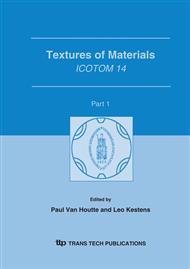p.1085
p.1091
p.1097
p.1103
p.1111
p.1121
p.1131
p.1141
p.1151
Study and Modelling of Some Variant Selections in bcc to hcp Phase Transformations
Abstract:
One very often observes that the texture inheritance in BCC to HCP phase transformation shows variant selections, even though no external stress field is applied. These variant selections are related to the metallurgical state, the microstructure and the texture of the parent phase. From our own investigations, we came to the conclusion that the variant selections we observed in some phase transformations of various materials were influenced at different degrees by the elastic behaviour of the parent phase. Considering the transformation strain of each variant and the elastic anisotropy of the parent, we have build variant selection models based on energy minimum of elastic strain and assuming different types of interactions. The simulation results of texture transformation of a zircalloy sample show that the elastic characteristics of the parent phases are key parameters involved in the variant selection.
Info:
Periodical:
Pages:
1111-1120
Citation:
Online since:
September 2005
Authors:
Price:
Сopyright:
© 2005 Trans Tech Publications Ltd. All Rights Reserved
Share:
Citation:


